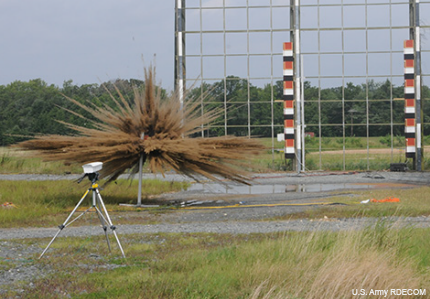ARL finds new ways to measure the fog of war
To build a better smoke grenade, the Army’s EETRANS can measure how obscurants transmit visual, infrared waves.

The Army tests a bispectral grenade, which counters thermal imagers.
The development of a new type of smoke grenade has led the Army to improve how researchers measure transmissivity—the amount of electromagnetic radiation that passes through obscurants or smoke.
Researchers at the Army Research Laboratory have partnered with New Mexico State University to develop the new Enhanced Electro-Optical Transmissometer System to collect and analyze the transmittance of battlefield obscurants, according to an ARL release. The system is capable of measuring from the infrared to the visible portion of the spectrum.
EETRANS will replace an older system that has been in use for 20 to 30 years, said Dr. Rudy Montoya, the project’s physicist, in the release. The new system is capable of providing more precise analysis without additional field work because the collected measurements can be used to create a model of what is happening.
The new technology is an example of how other research programs can help drive development in other areas. Part of the effort to improve measurement hardware and software was the result of the Army’s development of a bispectral-obscurant grenade, which would allow soldiers to counter thermal imagers, thermal-guided munitions and image intensifiers. For instance, soldiers using the grenade for concealment would also be able to evade infrared or night vision sensors that can see through normal smoke.
The Army’s Edgewood Chemical Biological Center, which conducted the initial development of the grenade, sought better ways to measure which were the most effective in blocking far-infrared waves.
"ECBC requested our expertise on this test to provide a new dimension of measurement to see through the cloud and further analyze the obscurants," Alejandro Gongora, the EETRANS project lead, said in the release. "Wideband systems have been used for decades, but they are not optimized. We developed this technique to do more precise measurements, which is why our team was contacted for this project."
"To our knowledge, spectral-wide measurements—from the visible to the far-IR regions—taken during field tests had never been accomplished in the past, in spite of a long and expensive history," Gongora said. "This is the least expensive approach because the EETRANS data can be utilized by multiple weapons systems without additional testing for specific narrow bands of interest."
The development of the system won’t stop at the infrared band, however. ARL scientists intend to refine the system, as well as investigate the analysis of ultraviolet and millimeter waves to measure the effects of obscurants created as battlefield byproducts. ARL envisions the use of EETRANS data for obscurant modeling and simulations, and to help improve seeker sensor improvements.
"The EETRANS is truly a survivability and lethality analysis tool," Gongora said. "This capability is in its early stages. We are looking forward to improving it and applying it for more customers."
NEXT STORY: Air Force seeks new ICBM technologies

